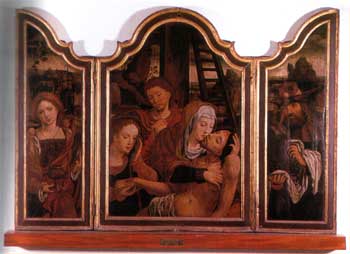|
|
| Circle of Jan van Scorel,
Lamentation over the Dead Christ with Joseph of Arimathea
and Mary Magdalene. Oils on panel. St. John's Museum,
Valletta. Photo credit: The Marquis Cassar de Sayn. |
|
to narrow this attribution
to the immediate circle of Jan Van Scorel (1495-1652).
As a young man Van Scorel had established contacts with the
Knights of St. John when, in 1519, he set out from Venice on
a pilgrimage to the Holy Land stopping among other places at
Rhodes where the Master Fabrizio Carretto commissioned him to
paint a plan of Rhodes(23).
He may also have painted other works and established useful
contacts that he exploited in later life when, as the most famous
Dutch artist of his generation, his workshop had contacts with
the Order's Commandery of Haarlem. The Lamentation triptych
seems to have been known outside the convent and a triptych
of the same subject in the Galleria Nazionale di Palazzo Abatelis,
at Palermo, is clearly based on it (24). |
It is possible that Caravaggio
saw this painting during his stay in Malta and was inspired
both by the poignant formal simplification of the Golgotha story,
and, more especially, by the emotionally charged detail on the
central panel where the Virgin presses her face against her
dead Son. An echo of its impact can, perhaps, be identified,
as suggested by John Gash, in the great painting of the Raising
of Lazarus, in the Museo Regionale of Messina, where the motif
is reinvented with dramatic intensity and sharpness in the way
in which Martha weeps over her dead brother. Here "the
abbreviated structure of Lazarus's face ... is a conscious reiminiscence
of the triangulated face of Christ in the Malta Lamentation.".
This is "one of the most memorable passages in Caravaggio's
entire oeuvre."(25). |
|
[23] A.T.
Luttrell, op. cit., 9.
[24] The painting (oils on panel) [Inv. 73] is labelled "School
of Anthwerp" and dated to the beginning of the 16th century.
It is iconographically almost identical but certain elements such
as the positioning of the volets with the Magdalene and Joseph of
Arimathea, and the cross and the ladder on the central panel are reversed
producing the effect of a mirror image. It could, in fact, have been
based on an engraving of the Malta painting. The quality is inferior.
[25] J. Gash, "Caravaggio's Maltese Inspiration",
Melita Historica, xii/3, 254-255. |
|
